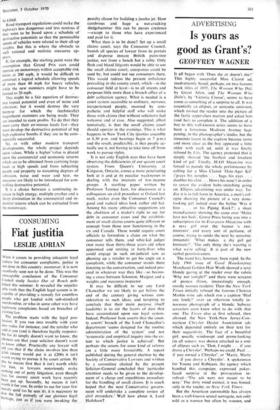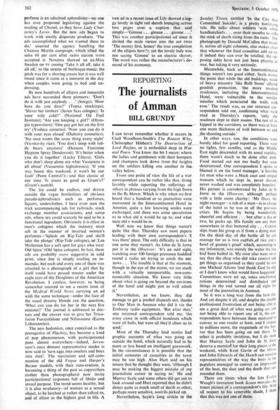ADVERTISING
Is yours as
good as Grant's?
GEOFFREY WAGNER
It all began with 'Does she or doesn't she?' This highly successful Miss Clairol ad, inadvertently based, perhaps, on two famous
book titles of 1895, The Woman Who Did, by Grant Allen, and The Woman Who Didn't, by 'Victoria Crosse', seems to have come as something of a surprise to all. It was essentially an ellipsis, or semantic omission, which invited the reader into the picture of the fairly upper-class matron and asked him (and her) to complete it. The addition of a boy to this well-known series seems to have been a fortuitous Madison Avenue hap- pening. in the photographer's 'studio, but the innuendo latent in the caption became more and more clear as the boy appeared a little older with each ad, until it was finally refused by Life. The agency protested that it simply showed 'the freshest and loveliest kind of gal.' Finally, MAD Magazine was forced to parody the whole performance by calling for a Miss Clairol `Date-Ager Kit' ('grays his temples . . . bags his eyes . . . doubles his chin ... blows his nose') in order to arrest the evident baby-snatching going on. Ellipsis advertising was under way. To- day it is in full form in America, a men's col- ogne -showing the picture of a very done- looking girl indeed over the byline 'Was it him . . . or his Piping Rock?', a sheet manufacturer showing the same over 'Make love not beds'. Grove Press luring you into a subscription for its Evergreen Magazine with a sexy girl over the banner 'A PRO- POSITION', and every sort of perfume, of course, trying to outdo the next by semantic innuendo: 'What makes a shy girl get Intimate?'. 'The only thing she's wearing is what we're selling'. It is part of the new verbal permissiveness.
The trend has, however, been rapid. in the July 1966 issue of Good Houskeeping Marchand Golden Hair Wash showed a sexy blonde gazing at the reader over the rubric 'Why not tonight?' and there were screams of protest (from, interestingly enough. mostly women readers). Then the New York Times initially refused the famous Chateau Martin wine ads which ran a caption 'Had any lately?' over an otherwise totally in- nocuous photograph of a blonde. Subway scrawlers soon knew what to do with that one. The Times also at first refused, then allowed, the New York-New Jersey-Con- necticut Chrysler Dealer Association ads which depended entirely on their text for their suggestivity. The face of a beautiful girl, usually windswept and prone-looking (in all senses), was shown attached to a rote of ellipses such as. 'Don, I might .. . if you drove a Chrysler'. 'Perhaps we could, Paul ... if you owned a Chrysler'. or 'Marty. Marty . . if you drove a Chrysler'. A spokesman for Young and Rubicam. the agency which handled this campaign, expressed poker- faced surprise at the provocation in- volved—'The ads were not meant to be sexy.' The dirty mind existed, it was hinted, only in the reader. or New York Times.
But the American automobile has always been a well-known sexual surrogate, not only sold as a woman but often by women, and
perfume is an admitted aphrodisiac—no one has ever proposed legislating against the mailing of Chanel, as they have Lady Chat- terley's Lover. But the new ads began to work with totally disparate products. 'The ads accomplished what we wanted them to do,' asserted the agency handling the Chateau Martin campaign, which lifted the sales 60 per cent after radio station WINS accepted it. Noxema showed an ex-Miss Sweden on Tv cooing 'Take it all off, take it all off,' to the strains of burlesque music; the pitch was for a shaving cream but it was well timed since it came at a moment in the day when couples were going to bed and un- dressing.
By now hundreds of ellipsis and innuendo ads have succeeded these pioneers: 'Don't do it with just anybody . . (Strega); 'How bare do you dare?' (Topaz stockings); 'Shiver her timbers' (Seven Seas cologne); 'Is your wife cold?' (National Oil Fuel Institute); 'Are you keeping a girl?' (Olym- pia typewriters); 'One guy got her on the first try' (Yashica cameras); `Now you can do it with your eyes closed' (Dubarry cosmetics); 'No man wants the same thing every night' (Va-rice-ity rice); 'You don't sleep with ted- dy bears anymore' (Demure Feminine Hygiene Spray Deodorant); 'It's better when you do it together' (Lucky Filters); 'Girls who don't sleep alone are what Vassarette is all about' (Vassarette nightdresses); 'If you stay home this weekend, it won't be our fault' (Penn Central !)—and that classic of our time 'Is yours as good as Grant's?' (Grant's scotch).
The list could be endless, and drawn outside the vague borderlines of obvious pseudo-aphrodisiacs such as perfumes, liquors, underclothes. I have even seen the trick accompanying ads for railroads, stock exchange member associations, and sump oils, where sex could scarcely be said to be a functional ingredient. Obviously it is rifest in men's colognes which the industry must sell in the manner of inverted women's perfumes—'Splash on Rip-Tide and she'll take the plunge' (Rip-Tide cologne),-43/,`,Lea Malleniun has a soft spot for guys who wear Old Spice' (Old Spice cologne). In fact, these ads are probably more suggestive in cold print, since One is simply reading an in- nuendo; but each and every one of them was attached to a photograph of a girl that by itself could have passed muster under the eagle eyes of the Daughters of the American Revolution. I confess, however, to being somewhat amazed to see a recent issue of the Medical World News carrying an ad with the same technique—under the face of the usual dreamy blonde ran the question, 'What can you do for her in the next five minutes?' The journal is addressed to doc- tors and the answer was to give her Trico- furon Furazolidone and Nifurozime (Eaton Laboratories).
The new hedonism, once conceived as the prerogative of Playboy, has become a kind of pop phenomenon, with participational puns almost everywhere—indeed, Seven- teen's once demure representative reader is now said to 'turn eggs into omelets and boys into men'. The narcissism and self-com- munion of the old Vogue and Harper's Bazaar models, with their auto-erotism, is becoming a thing of the past as copywriters (rather than photographers) now invite participational responses full of libido and sexual purpose. The trend seems healthy, but it is also revelatory—of woman as a sexual object, to be lurched at rather than talked to, and of allure as the highest goal in life. A
vast ad in a recent issue of Life showed a leg- gy lovely in tight red sheath lounging across two pages over a caption that said simply—`Gimme ginune . . . gimme . . This was another participational ad since it invited the male viewer into the act (was 'The money first, honey' the true completion of the ellipsis here?); yet the lovely lady was not saying `Gimme' to an electric shaver. The word was rather the manufacturer's de- mand of his economy.







































 Previous page
Previous page